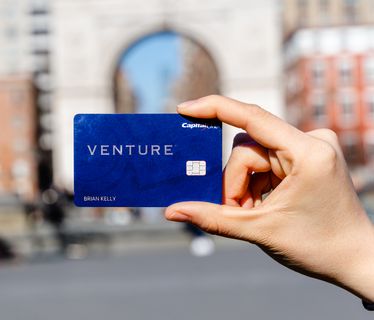From credit newbie to credit wizard: Here’s a 5-year strategy for rewards cards
Your credit journey will seldom be linear, as credit cards are just one facet of your credit portfolio.
While it may take less than five years for some people to qualify for a top-tier luxury card (like The Platinum® Card from American Express), others — like those who are in graduate school and prioritizing paying student loans — may find that it takes more than five years to get a premium card.
That’s why it’s important to start building credit as soon as possible. If you can maintain a good (or excellent) credit score, it will help you unlock the lowest interest rates possible when it comes time to apply for an auto loan or mortgage. It also will pave the way toward receiving approval for a premium rewards card, opening up all kinds of opportunities to maximize your travel.
To stay on track, even as your credit ebbs and flows, refer to this five-year plan (and tailor it to suit your financial situation). Before you know it, you’ll achieve that goal of spending your points and miles on an aspirational business-class flight or overwater bungalow in the Maldives.
New to The Points Guy? Sign up for our daily newsletter and check out our beginner’s guide.
In This Post
Year 1: Build your foundation

Year one is all about mapping out what your first credit card should be, which can vary depending on where you are on your credit journey.
Regardless of when you start establishing credit, the guiding principles are the same: Always pay your bill on time and in full and never charge what you can’t pay off. For additional insights, here are TPG’s 10 commandments of credit card rewards to master during your first year of card ownership.
Before you apply for your first credit card, there are a few details to factor in.
Academic pursuits
If you’re studying in a two- or four-year institution, this is actually the perfect time to open a student credit card. I can’t stress this enough, as being a student grants you an automatic pass from the otherwise stringent requirements that issuers require on “normal” credit card applications. Student credit cards are intentionally geared to those who don’t have any credit history or a large income, so your on-campus job or internship can count on your application.

Some of our top picks include the Capital One SavorOne Student Cash Rewards Credit Card and the Chase Freedom Student credit card, both of which have no annual fees and terrific rewards rates to help you earn cash back on your everyday expenses.
I was automatically approved for a student credit card on my 18th birthday before starting college. While my credit line was admittedly limited at first, my student card helped me grow my credit score, as I used it solely to pay for essential expenses (think: textbooks and meals). By the time I graduated, I already had four years of credit history under my belt. My friends who didn’t follow a similar strategy struggled to get approved for their first credit card upon graduation since they were no longer students and had no credit history needed to qualify for most credit cards.
Related: Capital One’s two new credit cards are the best for college students
Low credit scores — or perhaps no credit history whatsoever
If you’re no longer in school or have a credit score that’s less than ideal, don’t fret: Student credit cards aren’t the only way to access credit.
You can start to build credit by opening a secured credit card. These kinds of cards require a fully refundable security deposit that determines your credit line, so if you put down $500 initially, that means your credit limit will be $500. Other than this aspect, it operates just like a “normal” credit card. Over time, the issuer may eventually offer you a higher credit line or automatically convert your secured credit card into a traditional credit card, but this requires proving that you can pay your statement on time and in full. We recommend checking out the Capital One Quicksilver Secured Cash Rewards Credit Card or the OpenSky® Secured Visa® Credit Card if you’re considering a secured credit card.
You may also qualify for beginner credit cards, so don’t forget to shop around and pay close attention to how issuers market their cards. A friend of mine, for instance, qualified for the Capital One QuicksilverOne Cash Rewards Credit Card as her first card, which comes with a $39 annual fee and a 1.5% earning rate on all eligible purchases. Capital One denotes it as an option for people with “fair credit,” which falls in the FICO score range of 300 to 669, so it’s an especially appealing option for beginners.
Status as an authorized user on a credit card
If you’re lucky enough to get added as an authorized user on a credit card — most commonly by your parent or spouse — you will likely inherit that individual’s credit history. So long as they exercise good credit habits (i.e. paying their statements on time and in full), you will benefit as an authorized user. That means you can likely qualify for bigger (and better) rewards credit cards, including the Chase Sapphire Preferred Card or the Citi® Double Cash Card, two of our favorite options for your first credit card.
Remember, you can ask a trusted friend or family member to add you as an authorized user on their credit card instead of applying for your own card outright. You’ll want to maintain perfect credit habits, though, as this will affect both your credit score as the authorized user and the credit score of the primary cardholder.
Related: Credit cards with the greatest value for authorized users
Year 2: Apply for your first travel credit card

After you’ve spent a year familiarizing yourself with credit cards (and perhaps ditching or, at least, using that debit card less frequently), it’s time to graduate to the next step: applying for your first travel credit card.
Once you’ve established at least a year of credit history — assuming you’ve stayed on top of paying your bills — year two should unlock lots of possibilities for travel cards.
But before we discuss our front-runner cards, let’s delve into why we prefer travel credit cards over cash-back cards.
Yes, cash-back cards are straightforward. For example, the Wells Fargo Active Cash℠ Card (rates & fees) offers 2% unlimited rewards on eligible purchases. That means a $100 purchase will garner $2 in rewards, which you can redeem for purchases on your statement credit, through gift cards or as cash or a check. Your rewards are only ever worth 1 cent each for cash back.
But with a travel credit card, you’ll unlock a larger welcome bonus, greater earning potential with bonus categories where you typically spend the most (for example, 4 points per dollar spent on groceries) and the ability to better maximize the value of your rewards when redeeming for travel.
To illustrate this, my first travel card (which I added after I opened my student card) was the Delta SkyMiles® Gold American Express Card. I then redeemed the SkyMiles I earned on the card for flights operated by Delta or its SkyTeam partners, and I’ve received great deals this way.
For instance, I could redeem 4,000 SkyMiles for a one-way flight from Raleigh, North Carolina, to New York City or pay $79 in cash. That translates to 1.98 cents of value with my SkyMiles (divide the cash price by the number of miles required), which is almost double what I’d ever get as cash back. TPG also has its own set of valuations, updated monthly, for analyzing the estimated worth of each airline or hotel currency, but travel credit cards are the key to getting more value out of your rewards.
Remember, you should never close your first credit card, even if you’ve stopped using it after adding your shiny, new travel card to your wallet. Part of your credit score is determined by the length of your credit history, so you’ll want to keep your first credit card as long as possible.
As most first credit cards don’t have annual fees, there’s no harm to keeping them tucked away in your sock drawer and using them a couple of times per year to ensure that your account is active.
With that said, where should you start? Picking a travel credit card — especially your first one — may seem like a daunting task, so begin by understanding the three kinds of travel cards available.
General travel credit cards

General travel cards are ones that are tied solely to a bank. For example, you could open the American Express® Gold Card to earn Amex Membership Rewards points or the Citi Premier® Card to earn Citi ThankYou points.
The beauty of these programs is that their points are “transferable” to the issuer’s airline and hotel loyalty partners. It would take too long to list out every possible option, but you’ll find that many issuers, like Amex, offer a whopping 20-plus partners, including popular options like Delta SkyMiles and Hilton Honors.
With these programs’ transferable points, you can move your earnings to partners’ loyalty programs. Doing so makes it possible to redeem points for partner services like business-class flights and upgraded hotel rooms.
We usually recommend starting with travel credit cards that have annual fees of $100 or less. This can help soften the blow of paying for a card if you’re used to only having a credit card that doesn’t carry an annual fee.
| Card | Annual fee | Sign-up bonus | Earning rate |
| Chase Sapphire Preferred Card | $95 | Earn 60,000 bonus points after you spend $4,000 on purchases within the first three months of account opening. According to TPG’s valuations, this sign-up bonus is worth $1,200. |
|
| Capital One Venture Rewards Credit Card | $95 | Earn 60,000 bonus miles after you spend $3,000 on purchases within the first three months of account opening. According to TPG’s valuations, this sign-up bonus is worth $1,110. |
|
| Citi Premier | $95 | Earn 60,000 ThankYou bonus points after you spend $4,000 on purchases within the first three months of account opening. According to TPG’s valuations, this sign-up bonus is worth $1,020. |
|
You’ll only need to pick one card to start. Since all of our general travel card recommendations carry $95 annual fees, this is the time to analyze your own spending habits and determine which credit card will help you maximize your everyday purchases.
Airline credit cards

Perhaps you may want to take things slow, since fully understanding how to earn and redeem transferable points can be quite confusing for the true beginner.
If you’re a mega-fan of a particular airline, you could open an airline credit card, as I did. I pretty much only flew Delta while in college since I lived in one of the airline’s focus cities. As I flew on the carrier at least a handful of times per year, I knew that I could save big if I opened a credit card with Delta. Not only did it give me a chance to earn and redeem SkyMiles, but it also came with some pretty sweet money-saving, elite-like benefits, such as a free checked bag on every Delta flight.
I only recommend going this route if you’re committed to one airline. Otherwise, a general travel credit card that helps you earn bonus points on all sorts of travel (not just travel with an affiliated airline) will be your best friend. Here are some of my recommendations for airline credit cards with annual fees under $100:
- Citi® / AAdvantage® Platinum Select® World Elite Mastercard®.
- Delta SkyMiles® Gold American Express Card.
- JetBlue Plus Card.
- United Explorer Card.
- Southwest Rapid Rewards Priority Credit Card.
The information for the Citi/AAdvantage Platinum Select and the JetBlue Plus cards has been collected independently by The Points Guy. The card details on this page have not been reviewed or provided by the card issuer.
Hotel credit cards

Like airline credit cards, hotel credit cards make it possible to earn and redeem points through a single hotel currency. If you have a preferred hotel chain and find yourself regularly staying at its properties, you may want to opt for this type of card.
Here are the top hotel cards I recommend with annual fees under $100:
- Hilton Honors American Express Surpass® Card.
- IHG® Rewards Club Premier Credit Card.
- Marriott Bonvoy Boundless Credit Card.
- World of Hyatt Credit Card.
Year 3: Supplement your cards strategy

By year three, you’ve gotten comfortable with the idea of using credit cards. Hopefully, by now, you’ve made some great redemptions that you’ve been dreaming about — one of my first experiences using points and miles was an unforgettable trip to South Korea to see my extended family for the first time in a decade.
That’s what makes travel credit cards so special: They make memories happen that you might not be able to afford outright with cash (or a debit card).
Now that you have a few years of using cards under your belt, things are getting serious. You’re interested in earning more points and miles in an efficient manner. Or, in other words, you’re ready to earn points and miles faster.
To make this happen, you’ll need to apply for more credit cards. This is where some people start to fall off, either because they don’t want to keep up with multiple accounts or don’t want to adversely affect their credit score.
I get it — these are all valid concerns. Know, though, that the strategy of adding one new credit card per year can actually improve your credit score in the long run.
How, you may ask? Your credit score is also determined partly by your credit utilization ratio. Ideally, you’ll want to spend 30% or less of the total credit available to you. So, while opening another credit card will knock your score by a few points in the short term, it should bounce back throughout the year. You’ll also effectively lower your credit utilization ratio by adding another source of credit. It seems contradictory, but it’s true.
That said, there are a few ways you can go about adding to your card portfolio.
Double down in one points family

Let’s say that you decided to pick the Chase Sapphire Preferred as your first travel credit card in year two. Excellent choice — now, you should consider applying for the Chase Freedom Unlimited, a no-annual-fee card.
While the Freedom Unlimited is branded as a cash-back card, it actually earns rewards in the form of Ultimate Rewards points. So, you can immediately combine all the points you accrue with the Freedom Unlimited with your Sapphire Preferred to help you earn more Ultimate Rewards points thanks to its favorable earning rate in certain categories.
And right now, if you apply for the Freedom Unlimited, you can earn an additional 1.5% earning rate on top of the normal bonus categories in the first year of account opening, up to the first $20,000 spent. That means you’ll earn:
- 6.5% on travel purchased through Chase Ultimate Rewards (usually 5%)
- 4.5% on dining at restaurants and drugstore purchases (usually 3%)
- 3% on all other eligible purchases (usually 1.5%)
As you can see, this is why you’ll want to carry the Freedom Unlimited in your wallet as a double-down strategy. On all other eligible purchases, the Sapphire Preferred only earns 1 point per dollar, but with the Freedom Unlimited, you could earn up to 3% cash back (3 points per dollar).
Consider all the purchases you make in a year that inevitably fall outside those bonus categories, from buying a new computer to home improvement purchases to dog grooming appointments, and it makes sense to carry both cards to your wallet.
At TPG, we’ve written many “double down” pieces to help you earn more points within the same family. Learn more here:
- The power of the Chase Trifecta
- Double down: The Amex Platinum and the Amex Gold
- Why you should double down with the Citi Premier and Citi Rewards+
- Double down: Why it makes sense to get the Amex EveryDay® Preferred Credit Card from American Express and Amex Platinum
- Double down: Why it makes sense to get the Hilton Surpass and Hilton Business credit cards
The information for the Amex Everyday Preferred card has been collected independently by The Points Guy. The card details on this page have not been reviewed or provided by the card issuer.
Focus on non-travel expenses

If you need ideas for your next card, look no further than the American Express® Gold Card, a perfect option for foodies or those who just have a lot of mouths to feed.
Although there’s a $250 annual fee (see rates and fees), you’ll quickly recoup it:
- Earn 4 points per dollar spent on U.S. supermarkets and restaurants, 3 points per dollar spent on flights booked directly with airlines or through Amex Travel and 1 point per dollar spent on other eligible purchases.
- Get up to $10 in Uber Cash every month for U.S. Uber rides or Uber Eats orders for up to $120 annually.
- Get up to $10 in dining credit every month toward Grubhub, Seamless, The Cheesecake Factory, Ruth’s Chris Steak House, Boxed and participating Shake Shack locations for up to $120 annually.
- Enrollment required for select benefits.
Amex Membership Rewards are one of the most valuable points currencies out there. In fact, TPG pegs each point at 2 cents each. So not only will you be rewarded heavily for your food purchases, but you’ll also get a great payout with your points when it comes time to book travel.
Open a cobranded credit card

If you opened a general travel card in year two, year three might be the time to open a cobranded airline or hotel credit card.
Another strategy that many TPG staffers swear by is “diversifying” your points and miles portfolio. Maybe you opened the Citi Premier in year two and you like it for its lucrative earning rate (3 points per dollar spent on gas, supermarkets and restaurants, hotels and air travel; 1 point per dollar spent on everything else). TPG values Citi points at 1.7 cents each, so that’s a 5.1% return on those bonus categories.
If you often stay at Hilton properties, you may have been eyeing the Hilton Honors Aspire American Express Card or the Hilton Honors Surpass. Both are very good Hilton cards, earning an incredible 14 and 12 points per dollar spend on eligible purchases at hotels and resorts in the Hilton portfolio, respectively.
While Hilton points are worth significantly less than Citi points (0.6 points each), that’s an 8.4% or 7.2% return, respectively, which is much greater than what the Citi Premier will offer you.
There are also a lot of other benefits on both cards, such as automatic Hilton elite status, airport lounge access and more. The takeaway is: sometimes it helps to diversify.
The information for the Hilton Honors Aspire has been collected independently by The Points Guy. The card details on this page have not been reviewed or provided by the card issuer.
Year 4: Apply for your first premium card

Once you’re in year four, it’s time to dream big.
However scary their annual fees may be, premium travel cards offer some of the most valuable benefits for frequent travelers. If you want to travel in luxury — whether that means unlimited access to airport lounges or hundreds of dollars in airline and hotel credits — you’ll eventually want to level up.
In this guide, we performed a “battle of the best premium travel cards” to compare annual fees, welcome bonuses, earning rates, benefits and more. Here are the seven cards we analyzed:
- The Platinum Card® from American Express: $695 annual fee (see rates and fees).
- Chase Sapphire Reserve: $550 annual fee.
- United Club Infinite Card: $525 annual fee.
- Delta SkyMiles® Reserve American Express Card: $550 annual fee (see rates and fees).
- Marriott Bonvoy Brilliant™ American Express® Card: $450 annual fee (see rates and fees).
- Hilton Honors American Express Aspire Card: $450 annual fee (see rates and fees).
- Capital One Venture X Rewards Credit Card: $395 annual fee.
Year 5: Monitor the landscape

By now, you will have at least four credit cards in your wallet. Perhaps this is where you stop if you’re happy with the cards you carry and are comfortable earning and redeeming your points and miles.
For year five and beyond, we recommend you look at what’s in your wallet and make sure you’re getting enough value from your cards each year to justify the annual fees.
If so, you can continue to keep a card and paying its annual fee.
If not, you can downgrade to a card with a lower (or no) annual fee. That will serve you better than downright canceling a card, as you will lose the credit history on that account.
Periodically, you may receive targeted offers to upgrade the current card you own and earn a bonus for doing so. For example, if you carry the Amex Gold, perhaps American Express will mail you an offer to open the Amex Platinum with a 25,000-point bonus for doing so. (Targeted offers subject to change at anytime).
You can jump on this offer to upgrade your card, which won’t impact your credit score since you’re not creating a new application, or you can decide to possibly apply for the Amex Platinum separately to earn its lucrative welcome offer— though doing so will temporarily impact your score.
Ultimately, this is the time to keep an eye on the landscape, see what you like and don’t like about the cards that you have, and apply for a new card if there’s a compelling offer that comes your way.
Bottom line
While many of us at TPG are experts in our craft, every person takes a different approach to cards. I hope that this five-year plan empowers you to do the same, as there’s no right way of doing things. The goal, of course, boils down to TPG’s mission all along: Showing you how to maximize your travel using points and miles.
So, don’t sweat the small stuff and take things slow. You’ll eventually have a cards strategy that will be well suited to your own travel habits and goals.
For rates and fees of the Amex Gold card, click here.
For rates and fees of the Amex Platinum card, click here.
For rates and fees of the Delta SkyMiles Reserve Amex card, click here.
For rates and fees of the Marriott Bonvoy Brilliant Amex card, click here.
For rates and fees of the Amex Hilton Aspire card, click here.
Featured photo by Astrakan Images for Getty Images.